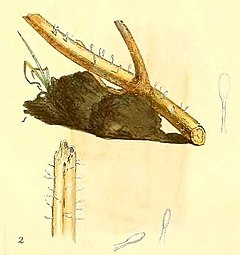Typhula is a genus of clavarioid fungi in the order Agaricales. Species of Typhula are saprotrophic, mostly decomposing leaves, twigs, and herbaceous material. Basidiocarps (fruit bodies) are club-shaped or narrowly cylindrical and are simple (not branched), often arising from sclerotia. A few species are facultative plant pathogens, causing a number of commercially important crop and turfgrass diseases.
| Typhula | |
|---|---|

| |
| Typhula quisquiliaris, as illustrated by James Sowerby | |
| Scientific classification | |
| Domain: | Eukaryota |
| Kingdom: | Fungi |
| Division: | Basidiomycota |
| Class: | Agaricomycetes |
| Order: | Agaricales |
| Family: | Typhulaceae |
| Genus: | Typhula (Pers.) Fr. (1818) |
| Type species | |
| Typhula incarnata (proposed)[2] Lasch (1838)
| |
| Species | |
| Synonyms | |
|
Cnazonaria Corda | |
Taxonomy
editThe genus was first introduced as a section of Clavaria by South African-born mycologist Christiaan Hendrik Persoon in 1801. He differentiated Typhula from Clavaria on the basis of fruitbody shape (Typhula having a distinct head and stem). The name was taken up at generic level by Elias Magnus Fries in 1818. Fries described four species in the genus. Subsequent authors described another 150 or so species in Typhula.[3]
The genus was revised in 1950 by E. J. H. Corner, who characterized Typhula species as having fruit bodies arising from sclerotia, the genera Pistillaria and Pistillina accommodating similar species lacking sclerotia.[4] A later and more specialist revision by Jacques Berthier (1976) placed both these latter genera in synonymy.[5]
Molecular research, based on cladistic analysis of DNA sequences, indicates that the genus is monophyletic and forms a natural group.[2] The type species, T. phacorrhiza, is not, however, closely related to other species in the genus and belongs in Macrotyphula. Rather than rename all other species currently referred to Typhula or Macrotyphula, a proposal is being made to change the type species of Typhula to T. incarnata.[2]
Description
editBasidiocarps (fruit bodies) arise singly or severally from a sclerotium or directly from the substrate. Fruit bodies are filiform (hair-like) to club-shaped, typically with a distinct sterile stalk and fertile head, normally white, in some species buff to pink, or with a dark reddish stem. The sclerotia (when present) are spherical to lentil-shaped, hard and horny, yellow-brown to blackish brown. Microscopically, the hyphal system is monomitic, the hyphae with or without clamp connections. The basidia produce 2 to 4 basidiospores that are smooth (lobed in one species), colourless, and amyloid or inamyloid.[5]
Habitat and distribution
editTyphula species mostly occur as saprotrophs on dead herbaceous stems, fern stems, grass stems, fallen leaves, and woody detritus. Some species occur on a wide range of host plants, others—such as Typhula quisquiliaris on bracken—appear to be host-specific.[5] A few species are or can become facultative (opportunistic) parasites of crops and turfgrass.
Most species have been described from the north temperate zone, but little research has been undertaken in the tropics or southern hemisphere, where they are either less common or (as yet) overlooked.[5]
Economic importance
editThe psychrophilic species Typhula canadensis,[1] Typhula ishikariensis, and Typhula incarnata are the causal agents of grey snow mould (also called speckled snow mould or typhula blight), a disease that can destroy turfgrass when covered for a long period with snow. It is a particular problem on golf courses established in unsuitable areas.[6] More importantly, the same two species can also damage crops of winter wheat, as can the unrelated Macrotyphula phacorrhiza.[7]
References
edit- ^ a b c Hoshino T, Tkachenko OB, Motoaki T, Tronsmo AM, Kasuya T, Matsumoto N (2022). "Taxonomic revision of the Typhula ishikariensis complex". Mycoscience. 63 (3): 118–130. doi:10.47371/mycosci.2022.03.003. PMC 10042319. PMID 37089628.
{{cite journal}}: CS1 maint: multiple names: authors list (link) - ^ a b c Olariaga I, Huhtinen S, Læssøe T, Petersen JH, Hansen K (2020). "Phylogenetic origins and family classification of typhuloid fungi, with emphasis on Ceratellopsis, Macrotyphula and Typhula (Basidiomycota)". Studies in Mycology. 96: 155–184. doi:10.1016/j.simyco.2020.05.003. PMC 7388190. PMID 32774511.
{{cite journal}}: CS1 maint: multiple names: authors list (link) - ^ "Index Fungorum - Search Page".
- ^ Corner EJH. (1950). A monograph of Clavaria and allied genera. Cambridge University Press.
- ^ a b c d Berthier J. (1976). Monographie des Typhula, Pistillaria et genres voisins. Société Linnéenne de Lyon.
- ^ "Jan2002". Archived from the original on 2013-04-10. Retrieved 2013-02-21.
- ^ Schneider EF, Seaman WL (1986). "Typhula phacorrhiza on winter wheat". Canadian Journal of Plant Pathology. 8 (3): 269–276. Bibcode:1986CaJPP...8..269S. doi:10.1080/07060668609501799.